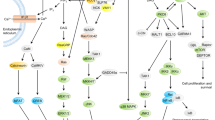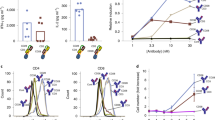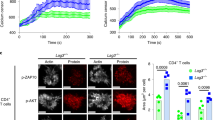Abstract
Activation of resting T lymphocytes is initiated by the interaction of cell-surface receptors with their corresponding ligands. In addition to activation through the CD3 (T3)-Ti antigen-receptor complex1, recent experiments have demonstrated induction of T-cell proliferation through the CD2 (T11) molecule2–4, traditionally known as the erythrocyte(E)-receptor, through which T cells can bind red blood cells (RBC)5–7. This 'alternative pathway' of T-cell activation2 was observed in vitro in response to combinations of anti-CD2 monoclonal antibodies (mAbs) that bind to distinct epitopes of CD2, such as mAbs against T112 plus T113 (ref. 2). The physiological importance of this activation pathway can be assessed only by studying the effects of a naturally occurring ligand of CD2 on T-cell activation. We have recently described such a ligand, a glycoprotein of apparent relative molecular mass 42,000 (Mr 42K) that is expressed on all blood cells and some other tissues9,11. Here we demonstrate that binding of this cell surface molecule, termed T11 target structure or T11TS, to CD2 (T11) induces reactivity in resting T cells to a mitogenic stimulus given by a mAb to the T113 determinant or by submitogenic concentrations of anti-T112+3 mAbs. Thus, one of the signals required for T-cell activation through the alternative pathway is provided by the interaction of CD2 with a naturally occurring complementary cell-surface molecule.
This is a preview of subscription content, access via your institution
Access options
Subscribe to this journal
Receive 51 print issues and online access
$199.00 per year
only $3.90 per issue
Buy this article
- Purchase on Springer Link
- Instant access to full article PDF
Prices may be subject to local taxes which are calculated during checkout
Similar content being viewed by others

References
Meuer, S. C. et al. Nature 303, 808–810 (1983).
Meuer, S. C. et al. Cell 36, 897–906 (1984).
Brottier, P., Boumsell, B., Gelin, C. & Bernard, A. J. Immun. 135, 1624–1631 (1985).
Holter, W., Fischer, F., Majdic, O., Stockinger, H. & Knapp, W. J. exp. Med. 163, 654–664 (1986).
Wortis, H. H., Cooper, A. C. & Brown, M. C. Nature new Biol. 243, 109–111 (1973).
Howard, F. D. et al. J. Immun. 126, 2117–2122 (1981).
Kamoun, M., Kadin, M. E., Martin, P. J., Nettleton, J. & Hansen, J. A. J. exp. Med. 153, 207–212 (1981).
Hünig, T. J. exp. Med. 162, 890–901 (1985).
Hünig, T. J. Immun. 136, 2103–2108 (1986).
Scheffel, J. W. & Swartz, S. J. J. Immun. 128, 1930–1932.
Hünig, T., Mitnacht, R., Tiefenthaler, G., Köhler, C. & Miyasaka, M. Eur. J. Immun. (in the press).
Krensky, A. M. et al. J. Immun. 131, 611–616 (1983).
Bert, G., Forrester, J. A. & Davies, A. J. S. Nature new Biol. 234, 86–87 (1971).
Hünig, T. Eur. J. Immun. 13, 596–601 (1983).
Seiler, F. R., Sedlacek, H. H., Kanzy, E. J. & Lang, W. Behring Inst. Mitt 52, 26–72 (1972).
Baxley, G., Bishop, G. B. & Wortis, H. H. Clin. exp. Immun. 15, 385–392 (1973).
Singer, K. H. et al. Proc. natn. Acad. Sci. U.S.A. 83, 6588–6592 (1986).
Yang, S. Y., Chouaib, S. & Dupont, B. J. Immun. 137, 1097–1100 (1986).
Shaw, S. et al. Nature 323, 262–264.
Larsson, E.-L., Andersson, J. & Coutinho, A. Eur. J. Immun. 8, 693–696 (1978).
Plunkett, M. L., Sanders, M. E., Selvaraj, P., Dustin, M. L. & Springer, T. A. J. exp. Med. (in the press).
Author information
Authors and Affiliations
Rights and permissions
About this article
Cite this article
Hünig, T., Tiefenthaler, G., zum Büschenfelde, KH. et al. Alternative pathway activation of T cells by binding of CD2 to its cell-surface ligand . Nature 326, 298–301 (1987). https://doi.org/10.1038/326298a0
Received:
Accepted:
Issue Date:
DOI: https://doi.org/10.1038/326298a0
This article is cited by
-
A threshold level of NFATc1 activity facilitates thymocyte differentiation and opposes notch-driven leukaemia development
Nature Communications (2016)
-
Augmentation of impaired tumoricidal function in alveolar macrophages from lung cancer patients by cocultivation with allogeneic, but not autologous lymphocytes
Cancer Immunology, Immunotherapy (1997)
-
Immunosuppression by breast cancer associated p43-effect of immunomodulators
Breast Cancer Research and Treatment (1996)
-
High expression of adhesion molecules/activation markers with little interleukin-2, interferon γ, and tumor necrosis factor β gene activation in fresh tumor-infiltrating lymphocytes from lung adenocarcinoma
Cancer Immunology Immunotherapy (1995)
-
The role of adhesion molecules in endothelial cell accessory function
Molecular Biology Reports (1993)
Comments
By submitting a comment you agree to abide by our Terms and Community Guidelines. If you find something abusive or that does not comply with our terms or guidelines please flag it as inappropriate.


